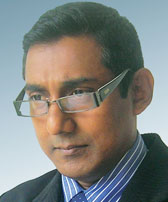|
Lend a helping hand:
Prevent loss of life
By Dhaneshi Yatawara

|

Dr. Indika Mudalige
|
Lack of emotional attachment among people in society or in a family
has created a vacuum for the much- needed space of a vulnerable person,
according to Dr. Indika Mudalige, Consultant Psychiatrist at the
Balapitiya General Hospital and a key organiser of the countrywide
program on suicide prevention
Do all these people who attempt to commit suicide lack emotional
attachment with other people, especially youth who are independent and
earning? Answering this question Dr Mudalige said, "There is a
significant number. When present society is compared with that of our
elders, it is quite clear that they are not connected. There was
connectivity among people in earlier societies - among family, friends
and community. It is far less now," Dr. Mudalige said.
Social media
In such a scenario, social media has crept in and is playing a 'big
game', where young people end up in unfortunate situations. "There are
people looking for relationships or emotional attachment through social
media.
They want to ventilate themselves through this when family or
teachers are not available to give them a hearing. They are trying to
fill the gap. Unfortunately, they get into trouble ending up with
married people and fake relationships," Dr. Mudalige said.
He also blamed the media for playing a role in this unfortunate
situation by giving undue publicity to suicides.
Insensitive
Thus giving food for thought to young people who are in a vulnerable
situation and contemplating suicide thus the report has a negative
impact.
"Some writers are insensitive to reporting suicides and give details
of the method by which a person has committed suicide.
This might be an avenue for vulnerable people to get an idea" Dr.
Mudalige said.
 Most people committing suicide do not suffer from mental disorder but
have deviated from the normal situation. Most people committing suicide do not suffer from mental disorder but
have deviated from the normal situation.
Sometimes they cannot visualize problems clearly. It is 'tunnel
vision' where the patient cannot see beyond the frame.
We see an acute stress problem as well in some patients," he said.
Dr. Mudalige said the basic responsibility of a psychiatrist,
counsellor or the loved ones of the patient is to take him or her out of
this frame - extend the helping hand to see a wider world.
"That person is not in a mental position to see this wider
perspective on his own.
He or she is mentally deviated from the normal situation and
desperately in need of help," he said.
If a person feels helpless, hopeless and worthless for a significant
period, family, friends or any close person must take care of that
person and get proper medical attention," Dr. Mudalige said.
'Be connected' is this year's theme. One world connected, simply
underlines the importance of connectivity in reducing suicide rates in
all countries. Considering the impact on our country, being connected in
a meaningful manner cannot be ignored considering the magnitude of the
problem of suicide in seemingly connected culture.
Psychiatrists
The connectivity which exists today in our culture may not be
protective enough, given the nature of competition instilled in to mind
for survival, psychiatrists warn. Perhaps we need to focus on a
different modes of connectivity, which fosters permissiveness, tolerance
and recognition of people with different abilities for what they are and
who they are and most importantly being emotionally available at times
of need.
Today in Sri Lanka an average of 11 people die per day due to suicide
according to latest statistics. The WHO's first global report on suicide
prevention, around one person dies due to suicide attempts every 40
seconds.
This was the main discussion on suicide prevention day this year,
which is marked annually on September 10. It was held last week themed
"Suicide Prevention: One World Connected."
Many of the panellists were of the view that the suicidal death rate
reduced drastically since 1995 but Sri Lanka came in to the the top
first numbers in the world suicide list. Suicide deaths of the North
Central Province farmers had a significant impact.
Markets
With the alarming situation, the Government took decisions to upgrade
medical facilities as well as to remove sources of poison from the
immediate environment and from markets in the area.
One particular agrochemical and two plant varieties were removed as a
matter of priority.
Although suicides rates have reduced in Sri Lanka over the years, new
official data shows that Sri Lanka still has one of the highest suicide
rates in the world, with almost 4,000 people killing themselves per
year. The majority aged between 15-44.
An associated disturbing phenomenon is the significant increase in
hospital admissions due to self poisoning especially with medicinal and
biological substances which has more than doubled from 1995 to date,
points out the Sri Lanka College of Psychiatrists.
"It had been around 48 patients per 100,000 in 1995 and by 2007 it
rose to around 115 patients per 100,000. This shows that although the
rate of suicides has fallen due to several reasons, the rate of people
attempting suicide has exponentially increased," said Professor Samudra
Katriarachchi, President of the Sri Lanka College of Psychiatrists.
The estimated numbers of lives lost due to suicide in Sri Lanka
surpasses that of casualties count during the country's war against
terrorism. According to Prof. Katriarachchi the alarming situation is
that majority of this group belongs to the younger generation.
Thus it is time to focus on suicide prevention as a person who
survived the first attempt in suicide is more likely to kill him or
herself within a year. It is similarly important to take effort to
prevent the initial attempt.
Economic burden
"It is important because suicide is a major public health concern if
the world and Sri Lanka in particular. Loss of lives, tragedy of loved
ones left behind in anguish, tormented survivors and economic burden on
the country and on health care costs are enormous at a time when the
nation is recovering from devastating effects of war on terrorism," he
said.
"Psychiatrists, psychologists, sociologists and economists would
analyse this problem in different perspectives, however understanding of
this complex phenomenon is important in combating the menace," Prof.
Katriarachchi said.
"As a medical officer I have seen many young lives being lost due to
ingestion of lethal pesticides and paracetamol overdose, used mainly by
young adults, impulsively,.
They regret the act later but the result has a fatal outcome," said
Prof. Katriarachchi explaining the agony of a suicidal attempt survivor.
Mental illness, in particular depressive disorder makes people
vulnerable to suicide and can be easily treated if detected early.
The other mental disorders which are associated with increased
vulnerability to suicide are substance use disorders, Schizophrenia and
personality disorders. Detection is important in prevention of suicide
and improving the quality of life.
Coping skills are an important aspect in suicide prevention as lack
of problem solving ability seriously makes people vulnerable to
maladaptive ways of coping leading to suicide.
In this respect, engagement in team activity and social activity from
the early stages of life makes children stronger in handling stress. |

